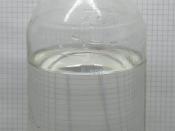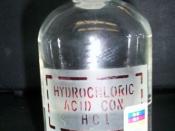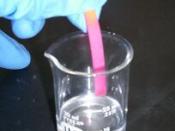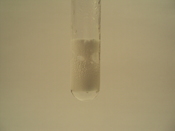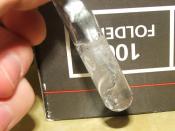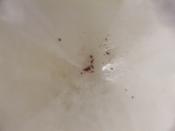Aim
It is to tell how the reaction between magnesium and hydrochloric acid will be effected if we change the concentration of hydrochloric acid.
Introduction
In the experiment the magnesium reacts with the hydrochloric acid to create magnesium chloride and hydrogen. The balanced formula for this is:
Mg(s) + 2HCL(aq) MgCl2(aq) + H2(g)
Magnesium + hydrochloric acid Magnesium Chloride + Hydrogen
Magnesium will react with hydrochloric acid, because it is higher in the reactivity series than hydrogen. The magnesium displaces the hydrogen in the acid, so it forms magnesium chloride and hydrogen gas.
There are many variables that I can change, which are the temperature and concentration of the hydrochloric acid, and the mass and the surface area of the magnesium strip. This is all true because they all link to the collision theory of particles colliding with enough energy to make a reaction. It is based on the idea that for a chemical reaction to take place, the reacting particles have to hit each other hard enough to break or form new bonds.
This is called a successful collision. When particles get stimulated or increased in number, the reaction will increase in rate because faster collisions will take place making more successful collisions.
This diagram shows five solutions hydrochloric acid and magnesium ribbon that are reacting. The arrows represent a simplified way to show how many successful collisions occur each second; therefore the more arrows there are, the faster the rate of reaction. They show how different factors can affect the rate of reaction against these two reactants (magnesium and hydrochloric acid). The original diagram shows how the solution will be with 1M hydrochloric acid and 5cm of magnesium strip. This is to compare with the other diagrams to see what the change is and if the reaction rate has decreased or increased.
The first one is to see what will happen if I change the temperature of the solution. As the temperature increases the speed and the power at which the acid particles hit each other increases, making the number of successful collisions with the magnesium strip increase.
The second one is to show how increasing the mass of the magnesium strip can increase the rate of reaction slightly because of the increased surface area but it is only slightly increased on the sides and so this is proportional to the rate of reaction of the original diagram. It is only slower than the original reaction because there is more of it to react with and produces more of the products.
Figure 3 shows the concentration of the hydrochloric acid increased so there are more particles to have more successful collisions. This is a faster reaction then the original reaction.
The final reaction has the same amount of particles of acid and the magnesium, but the magnesium has been cut to increase the surface area. This makes the acid particles more likely to have more successful collisions each second than the original reaction.
There are also many factors that I could record like the weight of the solution and the time it took for the magnesium strip to dissolve, but I am only recording the hydrogen produced. I chose this because I can make all the different concentrations of acid and I will be able to record it accurately. The only variable I am changing for this experiment is the concentration of the hydrochloric acid (measured in M), and maybe some that I have to keep constant all the time.
Prediction
I think that if I increase the concentration of acid I will get a faster rate of reaction therefore the gradient of the line on the graph of results will get steeper with increasing concentration. I have supported this with the explanation of the collision theory (above). As the concentration of acid increases the number of acid particles also increases, this will therefore increase the number of successful collisions with the magnesium. For example, a 2M acid will have twice as many particles per 20cm3 as a 1M acid. I predict that a reaction rate for a 2M solution will be double the rate for 1M because it's double the particles. The amount of hydrogen I will end up with when the reaction has completely finished will be the same for all the concentrations, but if a reaction is too slow and exceeds the set time I will stop taking results and it might not finish reacting.
Preliminary experiment
I was suggested to use 20cm3 of hydrochloric acid and 5cm of cleaned magnesium ribbon, and take the volume of hydrogen in the syringe every 10 seconds for the preliminary experiment to. I tried this but the reaction happened very quickly and the results of the volume of hydrogen were very spread out. The results for each 10 second interval were not accurate enough and there was not enough magnesium to get a high level of hydrogen. To solve this I increased the amount of magnesium strip to 8cm, and decreased the time interval to 5 seconds each. I tried this and the results were much more reliable to use and analyze.
Fair Test
To keep a fair test I will have to look into all the variables surrounding the experiment and only change the variable that I am testing on. The other variables are the temperature of the acid at the beginning, the volume of acid, the surface area of the magnesium strip, the length of the magnesium strip and if the magnesium strip is cleaned or not.
The magnesium strips were cleaned and cut correctly by the lab technician and I measured and inspected the strip each time I started the experiment to make sure it was ok for the experiment. Most of these variables for this experiment (except the surface area of the magnesium strip, if it is cleaned or not, and the temperature of the acid) can be changed but I had to stick with the value of these variables for the whole of my experiment.
When I set up the experiment I had to make sure the apparatus is tightly attached at the vulnerable points where some of the hydrogen could escape, like where the rubber tubing connects to the syringe. Before I attached the rubber tubing on I made sure there is no air in the syringe, by pushing the inside bit right down until the line where I read from is at 0cm3. To make sure the equipment is all air tight I had to attach the equipment together and pull the syringe up. If it sharply returns to its original position when I let go, it is air tight
The test had to be repeated to straighten out any anomalies and keep the results as accurate as I could.
Method
For each separate experiment I needed:
1 Conical Flask
1 Large Syringe with measurements
1 Bung attached to Rubber Tubing
1 Stopwatch
1 Measuring cylinder
8cm of cleaned Magnesium Ribbon
20cm2 of 2M Hydrochloric Acid
First I got all the apparatus on the list. Next I had to attach the bung on the conical flask, and the rubber tubing that is attached to, it to the syringe. This part of the apparatus has to be air tight to prevent any gas escaping from the apparatus. When I was ready I lifted the rubber bung off the conical flask to put in the reactants (magnesium strip and hydrochloric acid), making sure that I used a measuring cylinder to get the most accurate measurement of hydrochloric acid each time. I put the acid in first and then the magnesium. When I put in the 8cm of cleaned magnesium in with the acid, I started the stopwatch and put the rubber bung quickly over the flask to prevent gas escaping.
I wrote down the gas level on the syringe every 5 seconds over a maximum of 120 seconds (2 minutes). I then did this experiment again for each of the other concentrations of acid in 0.5M increments starting from 0M to 1.5M (0.5M, 1M, and 1.5M). I made these concentrations by adding a curtain amount of water to the 2M solution, but still maintaining the same amount (20cm3). For example, 15cm3 of acid added to 5cm3 of water to make 20cm3 of 1.5M solution. All the experiments have to be repeated at least two times to make an accurate set of results. I also needed safety goggles at all times to protect my eyes from the corrosive hydrochloric acid. Most of the equipment is glass so I had to be careful not to damage it, as shards of glass can cut though skin.
Results
Time (seconds) How much Hydrogen produced for each concentration (cm3)
0.5M acid 1M acid 1.5M acid 2M acid
1st test 2nd test Average 1st test 2nd test Average 1st test 2nd test Average 1st test 2nd test Average
0 0 0 0 0 0 0 0 0 0 0 0 0
5 4 4 4 10 15 12.5 25 25 25 50 45 47.5
10 6 7 6.5 20 25 22.5 50 50 50 75 70 72.5
15 8 9 8.5 30 35 32.5 65 68 66.5 85 82 83.5
20 10 11 10.5 40 40 40 78 77 77.5 87 85 86
25 12 14 13 48 55 51.5 83 80 81.5 87 85 86
30 14 15 14.5 57 60 58.5 84 83 83.5 87 85 86
35 15 17 16 62 70 66 85 84 84.5 87 85 86
40 17 19 18 70 75 72.5 85 84 84.5 87 85 86
45 19 21 20 75 78 76.5 85 84 84.5 87 85 86
50 21 24 22.5 80 80 80 85 84 84.5 87 85 86
55 22 25 23.5 81 81 81 85 84 84.5 87 85 86
60 24 27 25.5 83 82 82.5 85 84 84.5 87 85 86
65 25 29 27 83 83 83 85 84 84.5 87 85 86
70 27 31 29 83 83 83 85 84 84.5 87 85 86
75 29 33 31 83 83 83 85 84 84.5 87 85 86
80 30 33 31.5 83 83 83 85 84 84.5 87 85 86
85 32 34 33 83 83 83 85 84 84.5 87 85 86
90 34 38 36 83 83 83 85 84 84.5 87 85 86
95 35 39 37 83 83 83 85 84 84.5 87 85 86
100 36 40 38 83 83 83 85 84 84.5 87 85 86
105 37 41 39 83 83 83 85 84 84.5 87 85 86
110 38 42 40 83 83 83 85 84 84.5 87 85 86
115 38 43 40.5 83 83 83 85 84 84.5 87 85 86
120 40 45 42.5 83 83 83 85 84 84.5 87 85 86
Conclusion
The graphs I did from this table are a plot of all the averages of the concentrations and an initial reaction rate sketch. As I can see on the two graphs as the concentration increases the initial rate increases. To get the initial rate I had to plot the first two results (0-5 sec) of every concentration and work out the gradient from this. They are:
Concentration Gradient (y/x = cm3 per second)
0.5M 0.8
1.0M 2.4
1.5M 6.0
2.0M 9.167
It tells me that as the concentration of acid increases, the gradient increases so the rate of reaction (cm3 per second) increases. This proves the collision theory (above).
I predicted that all the results will end up the same but the ones that actually finished did not end up at the same point, but they were slightly higher or lower than each other. This is because of some slightly changing variables around the room and in the experiment even though I tried my best to keep the variables constant. Some results around the middle were found to be slightly affected with slight anomalies little bumps in the line, but these were minor and the line was mainly smooth.
I also said that I thought the reaction doubles with the concentration, but I found out from the gradients that it approximately quadruples when the concentration doubles. Other than that my prediction follows well with the facts. The lowest concentration (0.5M) had a very low reaction rate that it did not even reach very far up on the graph. This tells me that there is a significant change even when I decrease the concentration by 0.5M.
Evaluation
I feel that I could have done more experiments and make a smoother graph of the average. The largest difference in my results, on the 2M concentration for the same time, was 5cm3 apart which is a 50% error, but the average seemed to be near enough to be in the trend of results. This was probably by not putting on the bung fast enough when the magnesium was inserted into the acid. On the faster reactions the syringe level moves quite fast and reading from a moving object can be hard, so (if it was available) a data logger (attached to a computer) should have been used to read the data and record it to the nearest 0.5cm3 or even less, to get very accurate results. Even still there are other affecting variables that are very hard to keep constant so it would have been helpful to repeat the experiment again or even more.
The syringe could have stuck on the barrel around it giving me lower readings on curtain points or when the reaction stopped. I should have put some lubricant around it to stop this from possibly happening.
Further Work
I could test the concentrations for the ones in between like 0.25 and 0.75 to see how the rate of reaction changes. I could also change the acid reactant to sulphuric acid or phosphoric acid to see and compare the results with different molecular make-ups. The other reactant that I could change is the type of metal I use. Using the less reactive metals like zinc, aluminium, iron or lead enables me to test the higher concentrations like 3M or 4M because the reaction will go slower so I will be able to read the results off the syringe properly.
